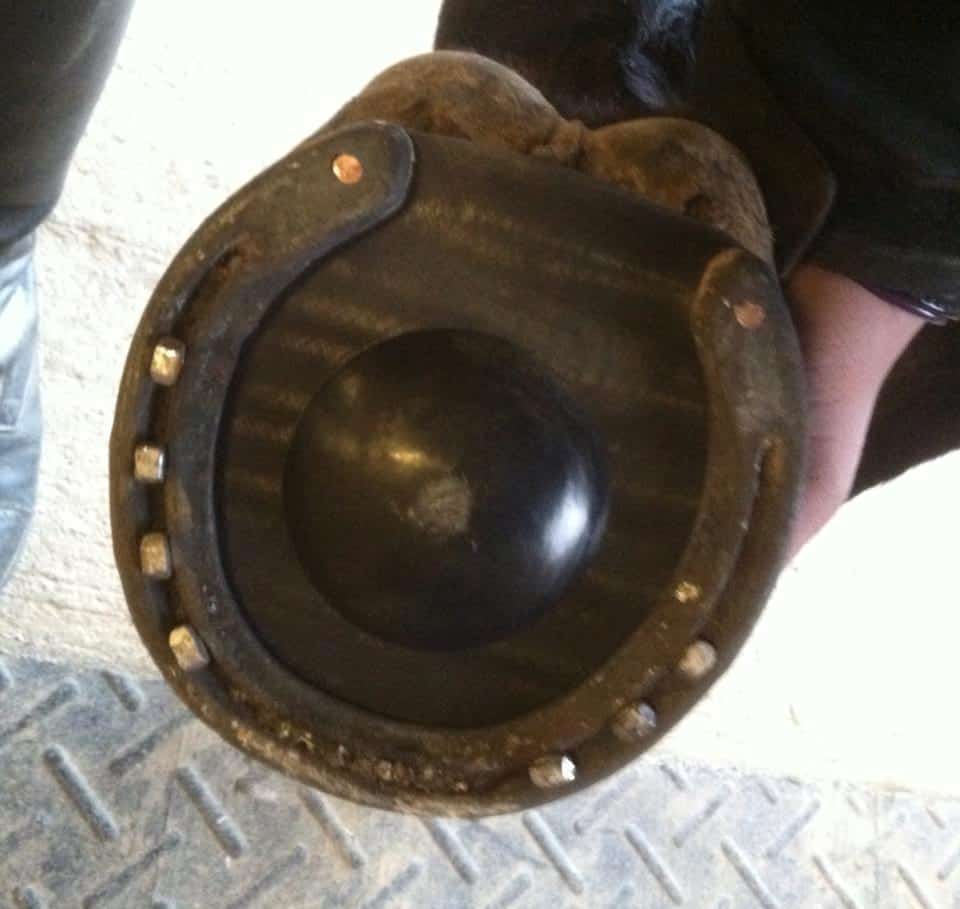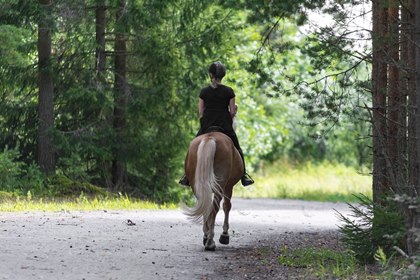Horse Hoof Pads: What Are They Good For?
- Topics: Article, Hoof Care, Hoof Care & Balance, Hoof Problems, Lameness, Shoeing

Sometimes horses need a little extra support or protection
A safe boarding stable, high-quality feed, free access to clean water, a secure turnout, a roomy stall—nothing is too good for your horse, right? And then the farrier comes out, and you notice that the gelding in the stall next to yours gets leather pads when he is shod. And the mare across the aisle has pour-in pads.
Your horse only wears shoes, no pads. And he only wears them in the summer when the two of you are on the go most. What gives? Is your horse missing out? Should he be wearing pads, too?
This is not a case of keeping up with the Joneses. Farriers apply pads to horses’ feet for a variety of reasons, most of them involving hoof problems.
Yes, there are other reasons for pads. In areas that receive heavy snow, for instance, farriers might apply anti-snowball pads or snow rim pads to shod horses to keep snow and ice from building beneath their feet.
But why should a horse need anything to come between hoof and shoe?
The Purpose of Hoof Pads
We love to see a set of smooth, shiny, straight, dense hooves on a horse. But it’s more complicated than this to identify a healthy hoof, which could appear any number of ways depending on the horse. We tend to be much better at noticing when something looks off—vertical cracks, horizontal rings, irregular bumps, wide white lines, chips in the hoof wall, thin walls, bruised or flattening soles, and so on.
Further, hooves that look healthy one season might change the next. Hoof growth typically slows during long stretches of cold weather. Hooves can get soft during wet or humid weather or turn hard as rock during dry, hot summers.
When problems appear, your farrier might advise pads for your horse.
“Pads can be applied in many different ways to address many different situations,” says Tom DuBois, a certified journeyman farrier in Wallkill, New York, and immediate past president of the American Farriers Association (AFA).
“There are numerous variables and conditions to consider when deciding when, how, and what type of pad to apply,” he notes. “Pads can be used to cover and protect, to elevate, and/or to support areas and structures on the bottom of the hoof. In cases that involve pathology (disease or damage), pads may be applied as part of a treatment recommended by a veterinarian.
Travis Burns, CJF, TE, EE, AWCF, is lecturer and chief of farrier services at Virginia-Maryland College of Veterinary Medicine, in Blacksburg, Virginia. “Pads are there to recruit the frog and sole into helping with load-bearing,” he adds. “They can spread the load, taking the load-bearing away from the hoof wall.”

Pads might be appropriate for horses that have thin, shelly hooves or quarter cracks, for instance. They can also serve as long-term bandages for some hoof conditions, he says.
A farrier might hear from the owner that a horse has a hard time on frozen ground or walking across gravelly surfaces, or he or she might notice bruising on the horse’s soles during a regular shoeing visit. In these scenarios the farrier and owner need to start thinking about pads, says Steve Kraus, CJF, head of farrier services and lecturer in large animal surgery at Cornell University College of Veterinary Medicine, in Ithaca, New York.
Farriers might also use pads to protect the sole from trauma, says DuBois, such as when you are riding in rocky terrain or other less-than-optimal footing.
“Horses that have thin soles and become ‘ouchy’ on rough ground will do better with pads,” says Kraus.
You can also use a pad to protect an injury to the sole, such as a puncture, but this is usually done at the recommendation of a veterinarian.
Types and Materials
A pad is not a pad is not a pad. There are several types, and each is designed for its particular job.
“The variety can be overwhelming, and that’s why it’s important that your farrier be experienced with pads,” says Burns. “Working with pads is a modification farriers need to learn very early on in their careers. To get certified, the AFA even requires that farriers demonstrate their knowledge of pads.”
Among the types are full wedge pads, bar wedge pads, frog support pads, flat pads, pour-in pads, rim pads, and full-support pads. Pads also come in different materials, typically leather or plastic, but they are available in rubber or metal, as well.
“Wedge pads, for example, can be used to artificially raise the hoof angle when conformation or injury needs assistance, says Kraus.
DuBois agrees, noting that wedge pads are helpful in certain cases when the hoof angle is low relative to the pastern angle. The farrier and owner usually make the decision to employ a wedge pad in consultation with a veterinarian, he notes.
Frog support pads help horses that need bony column support, such as laminitic horses, says Kraus.
In addition to causing the frog to share a portion of the load, reducing that placed on other areas of the hoof, these pads help maintain the position of the frog relative to other structures of the hoof, says DuBois.
“There also are pour-in pads,” adds Kraus. “These consist of a two-part mix of polyurethane that is poured into the sole after the shoe is nailed on. This sticks and molds to the sole and provides protection and shock absorption.”
He says the most common pads he uses are flat plastic pads made from polyurethane.
“Flat leather is also used commonly,” Kraus continues, “and is preferred by some farriers in some areas. Leather is more hooflike and plastic more consistent under moisture conditions. Leather gets soft and deteriorates in excessive moisture.”
Most often pads are applied in pairs, front or rear, to maintain symmetry, says DuBois. “However, many different combinations can be used based on the situation, such as in cases of mismatched hooves or of limb length disparity.”
He adds that most snow pads go on just the front hooves, but he does have clients that prefer putting snow pads on all four.
Farriers typically replace the pads with a horse’s normal shoeing cycle, every four to eight weeks depending on the time or year and region of the country, says Burns.
Don’t Forget the Packing
All pads—with the exception of rim pads—need some type of packing beneath to help prevent debris from migrating in and becoming trapped, says Kraus. Proper packing typically involves a filler such as pine tar compound, oakum (a fiber soaked in pine tar), or a liquid urethane product that the farrier injects into the space.
Without proper packing materials, trapped dirt and debris can encourage anaerobic (not requiring oxygen to survive) microbes to grow, which is why farriers also apply an antimicrobial, such as copper sulfate, beneath the pad, says Burns.
“The misconception that lingers today is that pads cause thrush,” he notes. “That may have been the case 15 years ago, but today an antimicrobial can be applied to keep the foot healthy. In fact, now pads can actually be used to treat thrush.”
Most pads are problem-free if applied properly, says Kraus, but he notes that “nothing is foolproof around horses. Deep muddy paddocks always present some problems with seepage of mud or sand.”
Be aware of your horse’s turnout conditions. Many owners don’t realize the degree to which moisture and silt can get under pads in wet and muddy environments, says DuBois.
Travis Burns
And although our intentions are to protect and support our horses’ feet, sometimes pads do more harm than good. “If the pad and packing materials are not properly applied, the horse will resent them because they can hurt as well as press on an already compromised area,” says Burns.
Also involve your veterinarian if your horse shows signs of lameness. The last thing you want to do is put a pad over an abscess, trapping the infection and making it even worse or more painful.
Pads can reduce a horse’s traction because they raise the frog off the ground. This might be a concern for riders doing speed work such as polo or barrel racing. If your farrier knows your needs, he or she should be able to find ways to increase traction while your horse wears pads.
Pads also can add weight to the foot. This can be a concern among riders in disciplines such as show hunters and Western pleasure, in which horses are judged on their fluid movement over the ground.
Possibly most annoying to horse owners, farriers, and horses alike is losing shoes because of pads. Pads can increase foot length, making it easier for the horse to pull or remove his shoes.”
“A pad that has good shock absorption due to it being made from a soft, spongy material will work up and down, (and) will loosen the clinches and the shoe,” says Kraus, adding that in these scenarios he prefers glue-on shoes.”
And, at the end of the day, “pads also add additional expense to shoeing a horse,” Kraus notes.
Take-Home Message
Some farriers don’t find much demand for pads, while others do. From their experiences in their areas of the country, farriers have developed particular preferences for pad materials.
“There are many variables to consider when applying pads, from conditions the horse is exposed to in work and turnout, its behavior, way of going, conformation, condition of its hooves, and whether any of these variables will change during the shoeing period,” says DuBois. “I don’t find the need to use a lot of pads in my personal practice at this point.”
Work with both a farrier and veterinarian if your horse falls into any of these categories that might benefit from some type of pad.
Written by:
Maureen Blaney Flietner
Related Articles
Stay on top of the most recent Horse Health news with












